5 Best Orienteering Compasses to Help You Keep Your Course
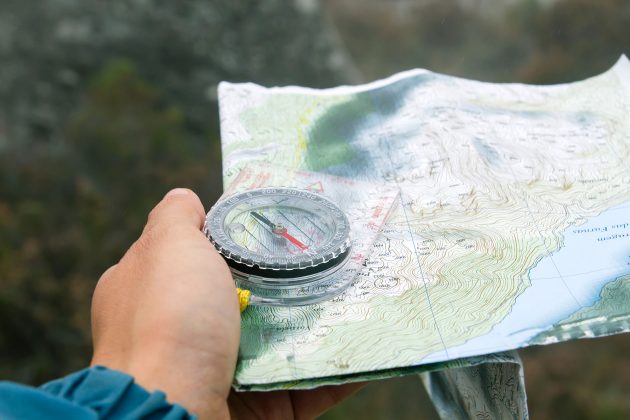
If you plan on going on adventures in the wild, it’s important to stay on track. When it comes to navigation, there are many options in the increasingly tech-savvy outdoors industry. Every year, companies are coming out with devices that make backcountry route-finding even easier than before. While a nice GPS or even app navigation on your smartphone is convenient, it does come with some drawbacks. All electronic devices have limited battery life and can malfunction in the field, leaving you stranded if you didn’t bring an alternative.
Ideally, anyone who is in the backcountry and needs to use map navigation should know how to orient themselves using a paper map and compass. Compass navigation is the original, time-tested version of orienteering. Knowing how to use one is invaluable for both weekend trips and emergency survival situations alike. Compasses are very durable and highly trustworthy when used correctly. For this reason, they are still one of the primary methods of navigation used by militaries, search-and-rescue teams, guides, and anyone else who needs to plot a course over unmarked terrain.
» Read our guide on understanding magnetic declination
Understanding how to correctly use a compass is an art. While many compasses only offer a basic idea of cardinal directions, hiking compasses are more complex and require some knowledge to utilize most effectively. It may take some time and practice to learn how to use one correctly, but the skill is well worth the effort put in. The best orienteering compasses will have enough features to allow for precise navigation using either a map or natural landmarks.
There are plenty of materials online to help you learn how to use compasses, and you don’t need to go far to do so. You can practice reading bearings on your compass in a local park using trees as landmarks. If you have a friend with a compass, you can stand in a field while sighting each other to check the accuracy of your bearings. At some point, it is important to practice using a compass with a paper map. This will allow you to test your skills in a real-life orienteering situation. It’s best to practice the basics first before you put your compass to use in the field.
We put together a list of some of the best orienteering compasses for backcountry navigation. These models are used by professionals and amateurs alike, on hikes, professional assignments, and in orienteering competitions. Our picks range from more basic compasses meant to help you with simple map navigation, to full-featured mil-spec designs that will withstand a beating and can be used in the dark.
1. Best Premium Compass: Silva Race Plate
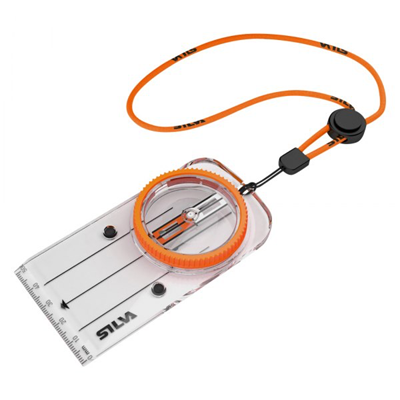
Silva of Sweden is one of the original fabricators of high quality compasses. Their Race Plate compass is designed for the orienteer in need of a no-fuss compass that works quickly and competently. The baseplate has been trimmed down to fit neatly in your hand more comfortably while in use. It comes with an adjustable lanyard that can be easily cinched up around your wrist to prevent accidental drops. The attachment point of the lanyard is slightly indented, so it can be used with a map without the need to remove your lanyard. The design of the Race Plate may appear simple at first glance, but this is intentional and gives you a very user-friendly interface. We love the updated needle, which shows up well on maps and gives you a high degree of precision. Apart from offering good visibility, the needle is also highly responsive and moves with you quickly as you turn. It’s small details like this that put the Silva Race Plate in a class above many other baseplate compasses.
When being used with a map, the Race Plate won’t slip around as much as other baseplate compasses. This is because it has helpful rubber feet on the underside. When you’re not using it with a map, they don’t seem to get in the way at all as they’re pretty low profile. Just like the size of the baseplate has been made smaller than previous models, so has the size of the capsule. This helps prevent the formation of bubbles, which can ruin your compass’s performance.
Apart from the compass and lanyard, the Race Plate also comes with a separate card for map measurements and stencil holes. This allows the compass to retain a clean design, while still giving you a great degree of function. The scale card actually gives you more ratios than most baseplate compasses provide, allowing you to chart your trip on a wider variety of maps. When you don’t need the scale card, you can always leave it at home. The separate scale card and simplified compass design pays off for orienteers who want their compass to be as easy to read as possible.
2. Best Mirrored Compass: Suunto MC-2
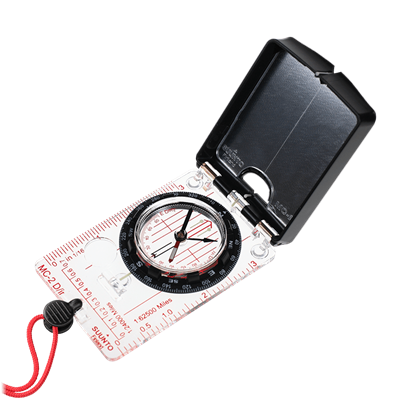
Like our top pick, the MC-2 from Suunto is a hybrid compass that can be used with a map, while also having a mirrored component to help with precision sighting (it doesn’t have the sighting lens that a true lensatic compass has). The MC-2’s clear baseplate with helpful markings allows you to track your progress easily across a paper map. The MC-2 also features a clinometer, to help you understand angles of inclination.
The mirrored operation of the MC-2 works just as well as a standard lensatic model in the right conditions. However, it is not as sturdy as a lensatic compass’s optical sighting system, and can potentially break if it is dropped. That said, it is easier to use for beginners because it takes less fiddling around.
The Suunto MC-2 comes in multiple designs. The MC-2 G features adjustable declination for global use. It also comes in different versions with metric and/or imperial measurements on the baseplate. All versions feature luminescent markings for low light use.
3. Best Versatile Compass: Brunton TruArc 10
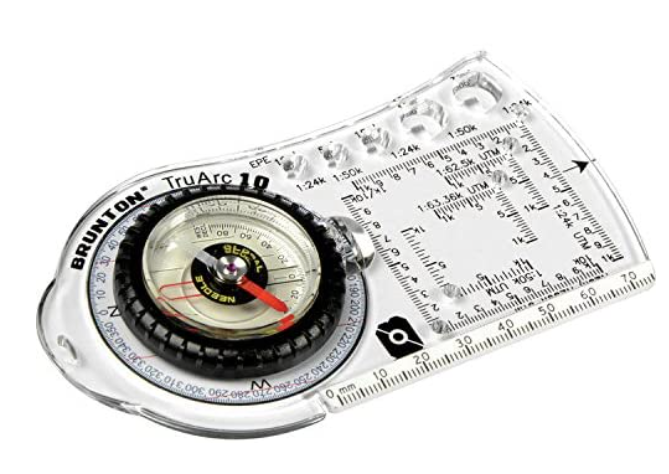
The wide variety of UTM Roamer Scales makes this compass stand out, especially with members of the search and rescue community who use the 1:24,000 scales often. These and the other navigation features offer great integration with GPS units, and this particular compass has proven itself able to last a long time and take a beating out in the field. Brunton’s EverNorth Magnet is built to resist demagnetization over time.
It has a double-gauge, baseplate that is durable and comfortable in hand, and the TruArc Global Needle tilts up to 20 degrees for balanced use worldwide. The tool-free declination adjustment is simple and fast to orient magnetic north to true north.
The compass also has inch and millimeter scales, as well as other guides.
4. Best Budget Compass: Brunton TruArc 3
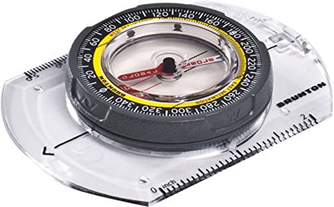
If you’re going to be using your compass primarily to orient yourself to a map, a basic orienteering/baseplate compass is easier to use with maps. It’s smaller and affordable. The Brunton TruArc 3 is a great baseplate compass that provides all the essential features needed for map navigation. The needle tilts up to 20 degrees and the declination can be easily adjusted, making the TruArc 3 a great choice for use anywhere in the world (it’s a significantly stripped down version of the TruArc 10 featured above).
The baseplate of the TruArc 3 comes with both inch and centimeter markings, to help with calculating distances. Apart from that, it has a very minimalist design. There is absolutely nothing superfluous about this compass, and that’s one of the reasons we love it so much.
It doesn’t matter if you’re a beginner or expert, the TruArc compass is a solid tool for map reading. It’s one of the most affordable compasses in its class, providing quality navigation at an amazing price. You won’t be able to sight as precise an azimuth as you would with other models, but for map navigation or general bearing taking, the TruArc 3 by Brunton is a great choice.
5. Best Thumb Compass: Silva Race 360 Jet
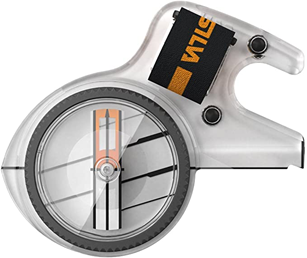
In the sport of orienteering, many competitors now choose to use thumb compasses instead of more traditional designs. A thumb compass works as an ultra-minimalist navigation tool that can be used quickly to take a general bearing and orient yourself to a map. Many features that other compasses have, such as sighting aids and measurements, are not here on the Silva Race 360 Jet. In lieu of these features, it has been optimized for running and competition use. The needle is engineered to give faster response times, allowing you to find your bearing quicker during races. The needle housing has been trimmed down to reduce the chance of bubbles forming over time. It has been built with speed in mind. The minimal markings across the baseplate make it easy to see a map underneath. The Race 360 Jet has a rotating housing, one feature that allows you a little more adjustment on the go.
If you’re just learning how to use a compass, this model is not recommended. Thumb compasses are designed for advanced users who need to prioritize speed over everything else. However, if you are experienced with navigation then you will likely appreciate the sleek design. For anyone considering participating in orienteering competitions, the Silva Race 360 Jet is an excellent compass that will help speed up your navigation.
Feature image by jessicahyde, Shutterstock
We are committed to finding, researching, and recommending the best products. We earn commissions from purchases you make using the retail links in our product reviews. Learn more about how this works.
 Your Privacy Choices
Your Privacy Choices